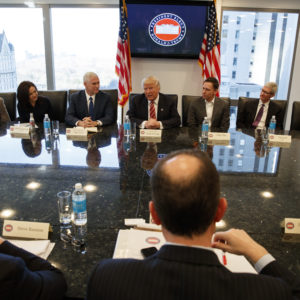President Trump is nearing his 600th day in office, which is ample time for him to develop, refine and pursue his economic policies to “Make America Great Again.” What better time is there to appraise his “MAGAnomics.”
Right now, those policies appear to be successful. The unemployment rate hovers around record-low levels, gross domestic product topped 4 percent in the last quarter and consumer confidence is as high as it’s been since the late-1990s technology boom. Yet economic policy isn’t just about the present but also the long-term. So how is MAGAnomics doing in that regard?
Trump’s biggest policy triumph so far is the fall 2017 tax legislation. The law’s lower business tax rate and the capped tax deductions are praiseworthy achievements. The former reduces the deadweight loss on business activity and brings the U.S. rate in line with the rest of the developed world. The latter reduces the regressiveness of some parts of the tax code. Encouragingly, future Congresses are unlikely to reverse these tax changes because they won’t want to restore a disadvantage on U.S. employers or reinstitute a tax break for the rich.
However, the overall reduction in Americans’ taxes will almost certainly not endure, because federal spending wasn’t cut. Trump and Congress will close the budget gap with more federal borrowing, returning America to trillion-dollar deficits.
Unless some future Congress undertakes serious budget-cutting, federal taxes will have to rise to pay those debts. Because of that, the 2017 tax changes are “fake” tax cuts.
Among the Trump administration’s top policy priorities are managing the nation’s international trade and reducing both legal and illegal immigration. On trade, Trump has backed out of the Trans-Pacific Partnership and is threatening to abandon similar pacts with Europe and the rest of North America. He is now taxing imported steel and aluminum, washing machines and solar panels, and has threatened tariffs on foreign automobiles.
Protectionism mainly harms the protectionist countries’ own citizens by raising their taxes. Trump says this is OK because his tariffs will force other countries to open their markets, claiming that “every country is calling every day” to make new agreements. But he’s yet to announce any new deals, and no serious negotiations are occurring. His actions have also led China, Canada and the European Union to raise tariffs on U.S. goods.
On immigration, Trump claims that inflows of both legal and illegal immigrants threaten national security and public safety. But both legal and illegal immigrants are less likely to commit violent and property crimes than native citizens, and the nation’s immigration vetting procedures — tightened heavily after 9/11 — have proven highly effective at screening out dangerous people.
These policies deprive America of both goods and workers. On immigration and trade, MAGAnomics is a failure.
In contrast, regulatory policy appears to be a MAGAnomics success. Following Trump’s taking office, the Republican-led Congress repealed more than a dozen regulations the Obama administration implemented in its last months in office. Trump appointees also put the brakes on current rulemaking in the federal agencies, smothering a slew of Obama initiatives in the pipeline. This has yielded a historic freeze in the growth of federal regulation and a slight decline in the cost of regulation.
But America needs more than a halt to new regulations; it needs a rollback and simplification of whole regulatory regimes that are inefficient, ineffective and harm general welfare. This happened in the great deregulatory wave of the 1970s–1990s, yielding large public benefits. Unfortunately, the Trump administration isn’t laying the policy groundwork and building the political coalitions necessary for another wave. As a result, MAGAnomics will likely have no long-term regulatory effects and its short-term achievements will be reversed the next time the Democrats have control of the White House and Congress.
With the federal debt in excess of $21 trillion and Social Security and Medicare in need of an additional $13.2 trillion and $37.2 trillion, respectively above their currently expected tax income in order to keep paying their current benefits in the decades to come, the president has two major action items to deal with. Yet Trump has repeatedly vowed to make no changes to Social Security or Medicare and plans to run up more government debt. This saddles the U.S. economy with uncertainty and threatens American workers’ retirement. Another MAGAnomics failure.
MAGAnomics is a slogan, not a serious plan to strengthen the nation’s economy. Because of that, Trump’s first 600 days of economic policy have been a dud.

